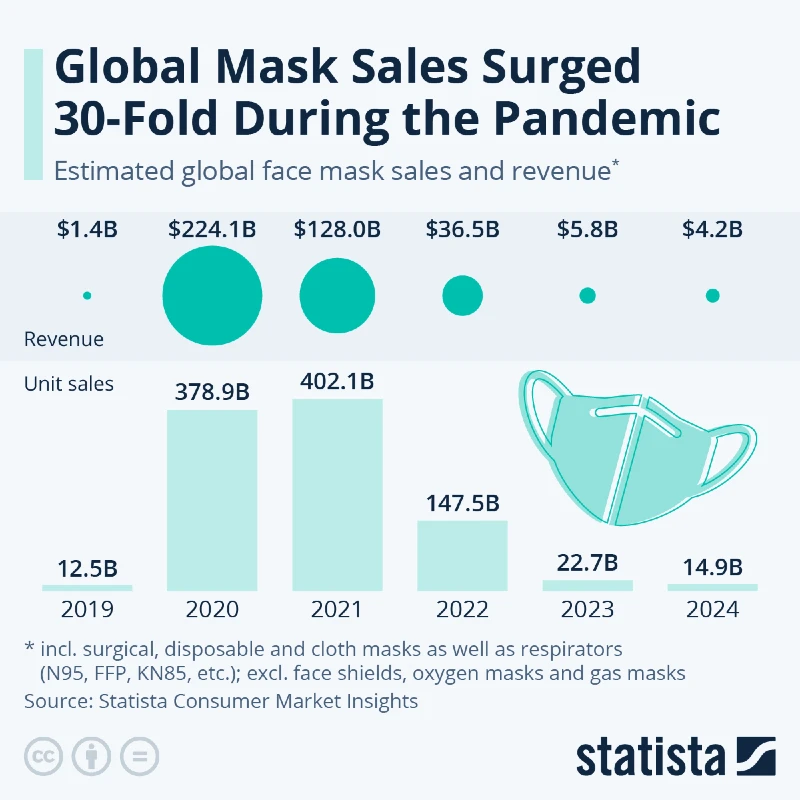A comprehensive study by a cross-disciplinary team from Bangor University has shed light on the significant role that media played in shaping public choices regarding mask-wearing throughout the pandemic. Their research scrutinized British and Irish media outlets’ coverage of masks and face coverings from March 2020 to December 2021, and the findings have been published in the Frontiers in Communication journal.
The media failed to highlight the negative impact of single-use facemasks on the environment, the report states, and the environment paid a price for their failure.
The study unveiled a clear media bias towards single-use surgical masks, while largely neglecting to address their detrimental effects on the environment and the challenges surrounding waste management.
The team highlighted that the environmental ramifications of disposable masks represent a seldom considered aspect of the COVID-19 pandemic.
Dr. Anaïs Augé, the study’s lead author, emphasized, “The influence of media extends not only to the content delivered but also in the manner it is presented. Our analysis revealed a prevalent use of the term ‘masks’ in reference to disposable face masks, whereas ‘face coverings’ were generally associated with homemade or commercially available fabric masks. Additionally, ‘masks’ were more frequently mentioned in contexts where their use was obligatory, while ‘face coverings’ appeared more in optional settings.”
Dr. Augé also noted a discrepancy between media terminology and official government language, stating, “Interestingly, the UK government typically reserved the term ‘masks’ for professional-grade equipment, encouraging the general public to use ‘face coverings’ instead. This disparity in language usage was not reflected in media coverage.”
Dr. Morwenna Spear, a materials scientist on the team, pointed out, “Early in the pandemic, there was already a scientific discourse around the safety of reusable face coverings and the environmental burden of disposable masks. Unfortunately, this crucial information was scarcely presented in the newspapers.”

Professor Thora Tenbrink concluded the discussion by linking the proliferation of waste to the media’s portrayal of single-use masks and their inadequate attention to environmental issues, stating, “Our findings raise serious questions about the newspapers’ effectiveness in providing the public with the necessary information to make conscious and informed choices regarding mask usage.”
The study originated from the Arts and Humanities Research Council project, led by Professor Nathan Abrams, titled “Between environmental concerns and compliance: How does media messaging affect motivation and choice between disposable versus reusable facemasks?”. The project sought to delve into the intricate factors influencing consumer preferences for different types of masks, and the broader implications on mask adoption and proper disposal.
America’s Single-Use Mask Waste Was Unprecedented, And Rarely Recorded
While the research is centered on British and Irish media, and, not surprisingly, no one is lining up to fund a similar study covering the American media, we can use their hard work highlight the potential impact in the United States, where the use of single-use masks also surged during the pandemic.
Firstly, the population of the United States is roughly 4.6 times larger than the combined populations of the United Kingdom and Ireland combined, meaning the US consumed far more single-use masks.
The increase in disposable mask waste is a pressing issue in the U.S., as it contributes to the already overwhelming burden on landfills and poses challenges for waste management systems. The Bangor University study serves as a wake-up call, highlighting the need for media outlets to shoulder their responsibility in accurately reporting and promoting sustainable practices.
In the early months of the pandemic, the U.S. experienced a surge in demand for personal protective equipment (PPE), including single-use masks. Health care facilities, essential workers, and the public were all in need of masks to help curb the spread of the virus. As a result, millions of single-use masks were produced, sold, and subsequently disposed of, often at higher than average prices.
More To Discover
- Bitcoin Miners Triumph in Court, Shielding Energy Secrets. Why It Matters.
- Nestlé Resists Investor Pressure to Reduce Unhealthy Ingredients in Its Products
- Exposed: The Climate Benefits of Cookstove Carbon Offsets Have Been Overstated By 1,000%
- European Bumblebees on the Brink: Climate and Habitat Woes, and Our Race to Save Vital Pollinators And 7 Solutions Being Tried Right Now

A report by OceansAsia, a marine conservation organization, estimated that globally, approximately 1.56 billion face masks entered our oceans in 2020 alone, contributing significantly to plastic pollution.
Considering the size of the U.S. population and its contribution to global consumption, we can safely assume that a significant portion of this waste originated from the United States.
The environmental impact of such widespread mask usage has been a subject of concern, as these single-use masks are predominantly made of polypropylene, a type of plastic, which can take hundreds of years to decompose. The disposal of these masks in landfills and their subsequent entry into waterways and oceans poses serious threats to wildlife and ecosystems.
Efforts have been made to mitigate the environmental impact of single-use masks, including promoting the use of reusable cloth masks, recycling initiatives, and awareness campaigns about proper disposal methods. However, the scale of mask usage during the pandemic has underscored the need for more sustainable solutions to manage PPE waste.
The consumption and subsequent waste of these single-use masks reached unprecedented levels, contributing to an increase in plastic pollution and highlighting the need for more sustainable practices.



















